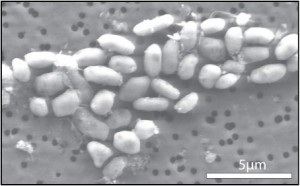On Thursday NASA announced it has discovered a completely new form of life at the bottom of Mono Lake, in California's Eastern Sierra. By all accounts, this is an extremely important discovery. From the New York Times:
Scientists said the results, if confirmed, would expand the notion of what life could be and where it could be. “There is basic mystery, when you look at life,” said Dimitar Sasselov, an astronomer at the Harvard-Smithsonian Center for Astrophysics and director of an institute on the origins of life there, who was not involved in the work. “Nature only uses a restrictive set of molecules and chemical reactions out of many thousands available. This is our first glimmer that maybe there are other options.”
Felisa Wolfe-Simon, a NASA astrobiology fellow at the United States Geological Survey in Menlo Park, Calif., who led the experiment, said, “This is a microbe that has solved the problem of how to live in a different way...”
Caleb Scharf, an astrobiologist at Columbia University who was not part of the research, said he was amazed. “It’s like if you or I morphed into fully functioning cyborgs after being thrown into a room of electronic scrap with nothing to eat,” he said.
Still, there was an element of disappointment among some in the media and blogosphere who had actually half-expected NASA to trumpet that it had found proof of extraterretrial life. Sheraz Sadiq explains in this QUEST post.
...before the embargo on the paper was lifted on Thursday, a flurry of speculation was set off earlier in the week that NASA had discovered proof of alien life, fueled by an ambiguous press release issued by NASA on Monday which trumpeted “an astrobiology finding that will impact the search for evidence of extraterrestrial life.” In fact, the embargo was lifted roughly two hours earlier than planned because reports of the findings, some of them erroneous, were already beginning to appear online in publications like The Huffington Post and the Guardian.
At the end of NASA’s Thursday teleconference, Mary Voytek, director of the Astrobiology Program at NASA headquarters in Washington, D.C. responded to a question from a USA Today journalist about the disappointment felt by its readers that in fact, NASA would not be pulling E.T out of a hat.
“I guess what I would say is that while being able to announce the discovery of an extra-terrestrial would be an incredible announcement, from our perspective, this is a phenomenal finding. It will require some paragraphs in textbooks to be rewritten,” said Voytek. “It will fundamentally change how we define life and how we look for it, maybe we’ll be able to find E.T. now because we’ve got more information about what we might be looking for,” she added.
Some of the speculation was prompted by this Nov 29 Kottke post with the provocative headline: "Has NASA discovered extraterrestrial life?", deducing the possibility from the specialties of the scientists listed in a cryptic NASA press release.
